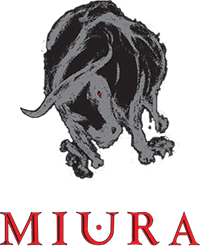2011 Miura, Pinot Noir, Pisoni Vineyard, Santa Lucia Highlands
Miura (myu rä) n. 1. Derived from Don Eduardo Miura, the most famous breeder of Spanish fighting bulls; for the Spanish, Miura is a legendary name signifying nobility, boldness and power.
Miura is our program that focuses on what I feel are the best regions in California for the growing of Chardonnay and Pinot Noir. Within each of those regions I have selected the vineyards that best exemplify that area stylistically and qualitatively.
Miura, Pinot Noir, Pisoni Vineyard, Santa Lucia Highlands
The Vineyard
This property has become the most talked about Pinot Noir property in California for good reason. The wines from this vineyard have an intensity and richness unmatched by any other Pinot Noirs anywhere. The vineyard is tucked among the hills and dry creek beds of the southern part of the Santa Lucia Highlands in Monterey. It lies in a secluded corner of the hills separating the Salinas Valley from Big Sur and the Monterey Coast. Vines are planted in several small blocks on what appears to be gravel and sand eroded down from the mountains. The blocks are whimsically named after people, objects and family members— “Camper,” “Mommy’s,” “Elias,” to name a few (our grapes come from the “Camper” and “Hermanos” sections. The site is dry, almost arid, but not particularly hot. Most of the vineyard faces east to southeast, capturing more morning than afternoon sun. The intensity with which this vineyard is farmed is unmatched in the Highlands, or anywhere else for that matter. We ferment the Pisoni with a measure of whole bunches in the bottom of the tank, and punch it down by hand. I like the moderate amount of tannin that adding some stems to the fermentation brings—just enough to give some refreshing grip to the mouth feel, and keep the wine from being too soft.
The 2011
While the press will downplay the quality of this vintage, mostly because of how poor it was for Napa Valley Cabernets, the cool summer and harvest allowed us to pick the grapes here 3 weeks later than normal, yet several weeks before the rains came that spelled disaster for later ripening varieties. This led us to produce one of our most complex and profound Pisoni bottlings.
342 cases produced
